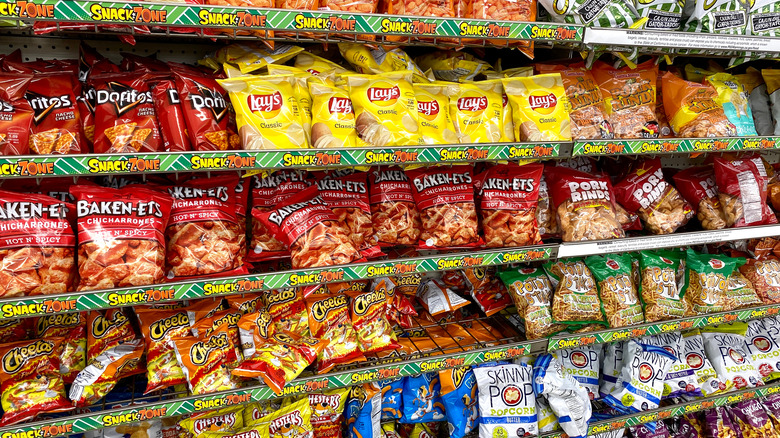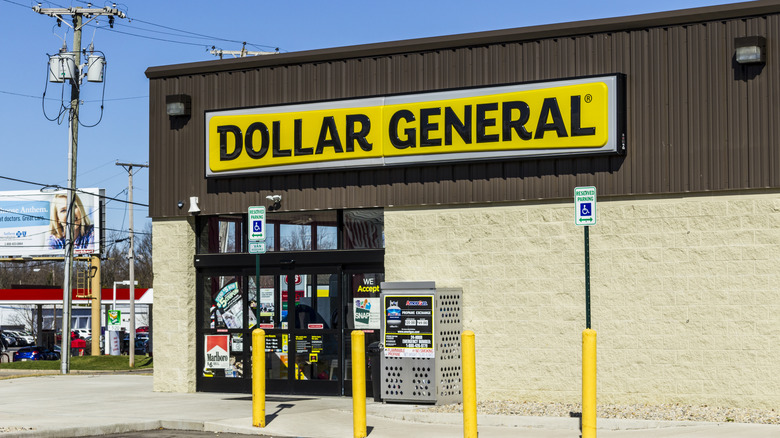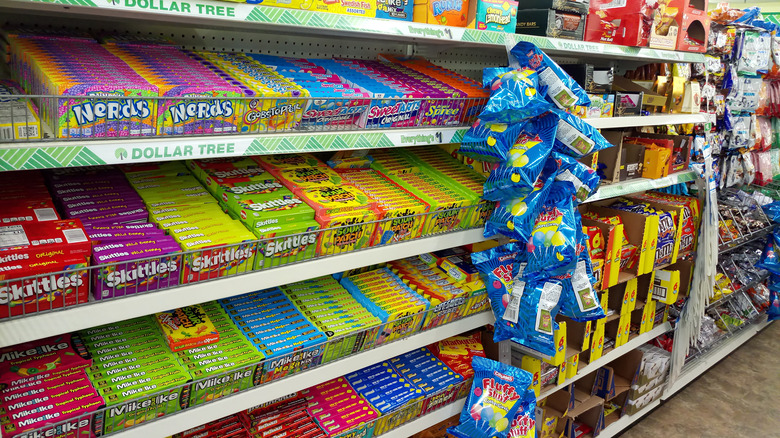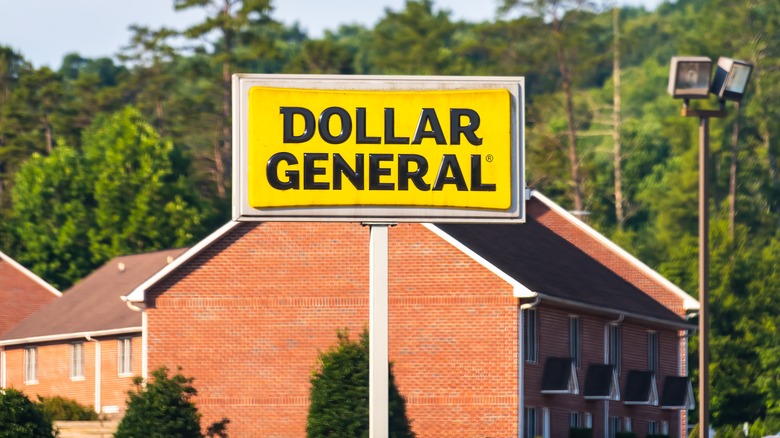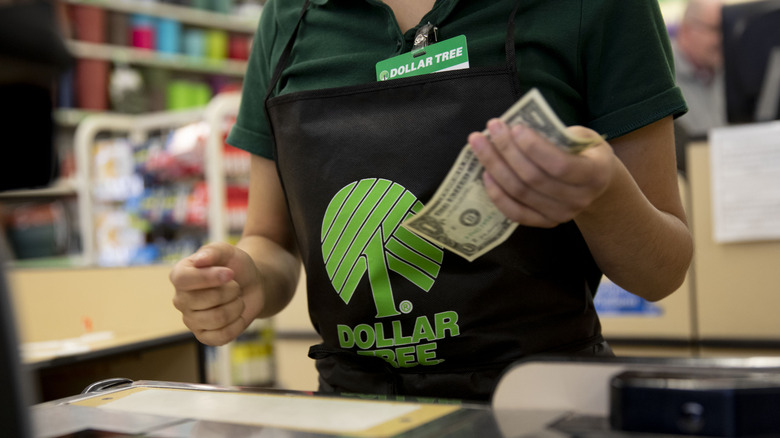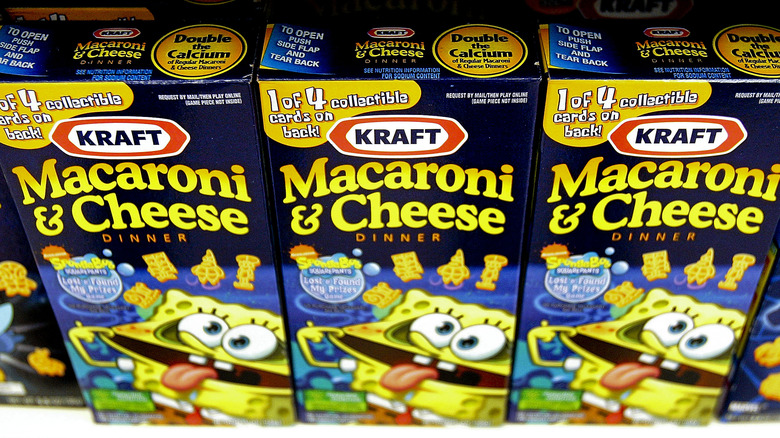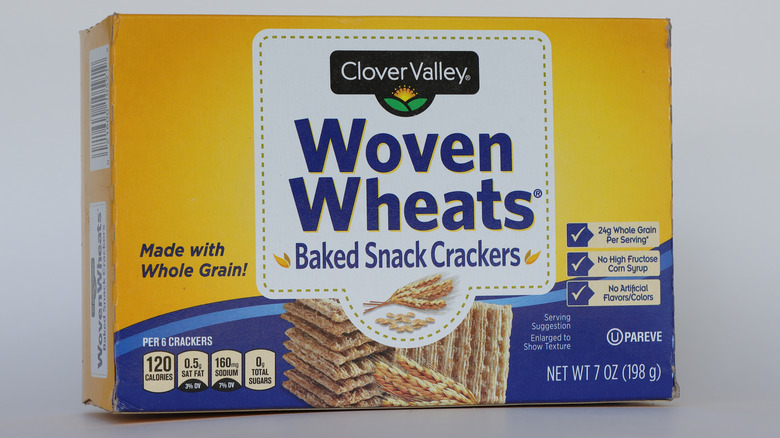7 Reasons Dollar Stores Can Sell Food For Really Low Prices
Most shoppers are familiar with dollar stores, where customers can purchase various goods, including food, at ostensible discounts compared to conventional retailers. Many of these stores stick as closely as they can to offering everything in the store for just a dollar a pop, while others, like Dollar General or Family Dollar, merely evoke the idea of savings with the word "Dollar" in their name. As inflation rolls on, it's natural to wonder just how these stores are able to sell food with price tags that appear so much lower than they do at your local supermarket or convenience store.
Fortunately, the dollar store business model isn't based on selling tainted meat or radioactive snacks — in fact, you might be surprised to even see more fancy foods at Dollar Tree. Rather, these stores depend on some basic economic factors and some retail sleight of hand to entice customers seeking deals and low prices, managing to turn a profit at the same time. Here are some of the ways this is possible, particularly in the realm of food.
1. They keep their overheads low
It's a basic economic fact that if you want to offer lower prices than your competitors, you have to cut your overheads. There are countless ways one can go about this, but some of the ways dollar stores accomplish it should be obvious. For one thing, they tend to be significantly smaller spaces than a supermarket, and some of them are even smaller than a corner convenience store. Less space means less rent, as well as lower costs to maintain the store. For perspective, the average square footage of a Dollar General location is pegged at 7,400 square feet, while the average Walmart, a store that is itself known for low prices, sprawls across 178,000 square feet on average. Even the pared-down Walmart discount stores measure in at an average of 105,000 square feet, which just goes to show how much space is being saved at a typical dollar store.
A quick look at the shelves of your local dollar store will also show how they tend to lack many of the departments that can add time and expense to the management of a supermarket. You're not likely to find fresh produce, baked goods, or deli meats in a dollar store, although Dollar General has expanded significantly into the field of fresh groceries in recent years.
2. They use non-standard packaging and creative pricing
If you're only paying a dollar and change for, say, a box of raisins, it's reasonable to think that you're paying less than you would at a grocery store. But take a closer look and you may find that, per raisin, you're actually paying more at a discount store than you would in a traditional supermarket. A Guardian story on the controversies surrounding the discount store business model offers just that example: one box of raisins at a typical dollar store weighs 4.5 ounces, while the seemingly more expensive box at a bigger store, with its price tag of $10.50, weighs in at 72 ounces. Do the math, and you'll see that the "deal" on the smaller box works out more expensive by weight.
This creative pricing extends to most foods you can buy. Similarly, a two-pound bag of flour might cost just a buck, while a five-pound bag from Walmart or Target will likely set you back less than the $2.50 you might expect from the same standard. While it's great for business it's not so great for customers, many of whom have no choice but to pay more for less food over time due to economic factors.
This is why you will often see familiar brands in non-standard packaging on the shelves at dollar stores. What looks like a good deal on the surface may involve paying significantly more by weight, so be careful out there!
3. They often serve neighborhoods neglected by larger stores
It's a sad fact of the American economy that not all communities have access to the same retail goods and services. One of the ways that Dollar General, in particular, has capitalized on this is by focusing many of its retail locations in low-income and/or rural neighborhoods that are not immediately served by competitors like Walmart.
Avoiding competition, particularly Walmart, has been their strategy since sometime in the early 2000s, providing each store with a built-in clientele who no longer have to drive to the next town over to shop. Unfortunately, this means that shoppers in these areas have to choose between convenience and getting the most for their money, but The Guardian also describes dollar stores as a "least bad option" in food desert areas. By giving shoppers in inadequately served areas a no-frills shop right down the street, they're able to do business with customers who are often neglected by more upmarket retail brands.
4. They tend to pay lower wages
One by-product of the discount store business model, with fewer bells and whistles you're likely to find at Walmart or Target, and one that contributes to lower overhead expenses is that they tend to pay their employees less than competitors do. That's not good if you're considering applying for a job at such a store, but it does mean lower prices for the customers inside.
Figures from the Economic Policy Institute in 2021 showed that 92% of Dollar General employees were making less than $15 per hour. Compare that with Walmart, where 51% were pulling in wages under that threshold, or Whole Foods where it was just 1%. If you've ever shopped at Whole Foods, you'll know that those higher wages are reflected in their prices, an unfortunate push-and-pull baked into the business of retail.
The EPI study shows Dollar General near the bottom in terms of hourly employee wages, even next to less comparable businesses such as Waffle House or Rite Aid. Unfortunately, working at a discount store isn't always proportionately easier in compensation for lower wages, and CNN even reported that police have called these stores "a robbery magnet."
5. They may products that cost more than a dollar
The $1 price tag gimmick is a great way to drive shoppers into a store, and Dollar General has created a whole brand associated with low prices, even while not offering or claiming to offer any sort of set price point on its products (the occasional Dollar General 1-cent snack deal notwithstanding). But even a dollar store that purports to be a place where everything costs a dollar can offer higher-priced items among their loss-leader stock.
It's an especially enticing hook for those shoppers who either can't or don't want to spend any more money than they have to, and while it is possible to make a profit on such discounted (or perhaps "discounted") items, higher price tags can mean higher profit margins for the owners of the store. These bigger-ticket items can justify offering those lower prices as a way to get people inside and spending money, and it's all part of the elaborate wheel-and-deal that is happening behind the scenes of every discount and dollar store.
6. They often have special wholesale arrangements with big brands
If you've never shopped at a dollar store, you might assume that its discounts come in the form of selling "off-brand" items at lower prices than you'd pay for Coca-Cola or the ever-popular Frito-Lay snacks at the supermarket. But this actually is not the case, and many of the biggest and most famous food and beverage brands in the country have come to realize the huge business potential and formerly untapped markets represented by dollar stores.
"There was a time the big consumer packaged-goods companies just hoped it would go away," Joel Rampoldt, a managing director at the financial consulting firm AlixPartners, told Fortune. "Now they need the dollar-store channel." In exchange, these big brands can offer non-standard packaging, special wholesale deals, and even eye-catching store displays, all of which allow the partnership between pricier name brands and discount dollar store pricing to be harmonious and profitable.
7. They offer their own private label and store brands
While many shoppers are doubtless pleased to see name-brand items at their local dollar store, others seeking the lowest possible prices are more than happy to pay a little less for a store brand. This same motivating factor that drives big supermarket chains to develop their own private label store brands also incentivizes Dollar General to do the same. These private label store brands cost retailers less, because the store isn't paying for the marquee brand name, and its control over both manufacturing and the various links in the supply chain allows costs to be kept lower than with name brands. All of these savings can be transferred over to the customer with plenty of profit left over.
Dollar General has turned the concept of store brands into its own cottage industry. The store's web page for its line of DG Brands products includes everything from Clover Valley food products to Good & Smart healthy snacks, plus plenty of private label brands for products outside the food realm as well. It's reasonable to assume that these private labels are more appealing to shoppers than slapping a "Dollar General" logo on the same products would be, which makes them something of a retail win-win.
